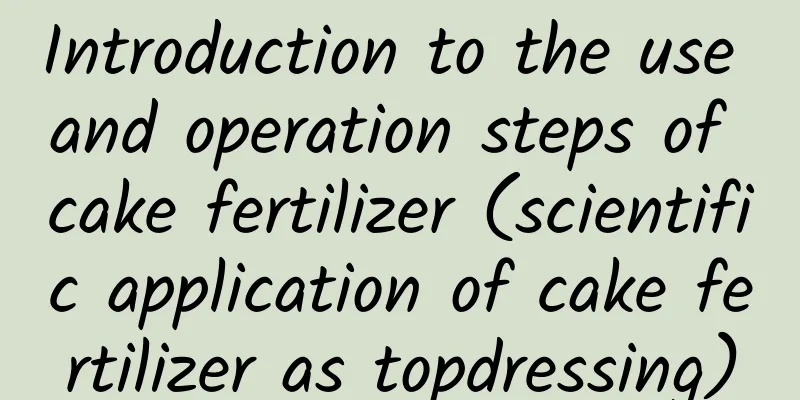Introduction to the use and operation steps of cake fertilizer (scientific application of cake fertilizer as topdressing)

What is cake fertilizerCake fertilizer is actually the residue left after oil crops are squeezed for oil. For example, after various seeds with high oil content are squeezed to remove oil, the remaining residue is used as fertilizer, which is generally called cake fertilizer . Cake fertilizer is often used on greenhouse vegetable crops and is a high-quality organic fertilizer. Applying cake fertilizer can not only improve the soil , but also improve the quality of crops . However, the nutrients in cake fertilizer can only be absorbed after fermentation. Composition and properties of cake fertilizerCake fertilizer is rich in organic matter and nitrogen, and contains a considerable amount of phosphorus, potassium and various trace elements. It generally contains about 75%~85% organic matter, 2%~7% N, 1%~2% P2O, and 1%~2% K2O. The nitrogen and phosphorus in cake fertilizer are mostly in organic form, with nitrogen mainly in the form of protein, phosphorus mainly in the form of phytochemicals and lecithin, and potassium mostly water-soluble. These organic nitrogen and phosphorus must be decomposed by microorganisms before they can be absorbed and utilized by crops. How to apply cake fertilizer scientificallyFermentation before useThe use of cake fertilizer after fermentation can effectively avoid its harmful effects . Because cake fertilizer contains organic matter, fermentation and decomposition will produce formic acid, acetic acid, lactic acid and other acid substances that are harmful to seed germination and young root development, especially when applied to sandy soil and dry land. This phenomenon can be avoided by fermenting it. Some cake fertilizers contain about 10% oil, which decomposes slowly in the soil, reducing the moisture content in the soil and preventing root absorption. In addition, if cake fertilizers are not fermented, they may burn the roots . Use as basal fertilizer or topdressingWhen used as basal fertilizer, it can be directly fermented and applied one week before planting. It is best to apply it to a depth of 10-20 cm in the soil layer. It is not suitable to apply it directly on the surface, and it is also not suitable to apply it too deep. If it is used as seed fertilizer, it must be fully decomposed to avoid burning the roots and affecting seed germination, or it can be applied to the soil as base fertilizer together with composted organic fertilizer, which is safer. When used as top dressing, it must also undergo fermentation. If it is not fermented, its fertilizer effect will be slower and the best time for top dressing will be missed. Specific application method of cake fertilizerApply it before planting the plants. First, dig the planting holes, apply about 100 grams of cake fertilizer to each hole, mix it evenly with the soil and then plant. This method of fertilization can increase crop yields by about 10%-20%, and it has good commercial quality and is particularly effective in increasing yields on cucumbers and tomatoes. When applying fertilizer in field management, we can also mix it with base fertilizer. The amount of fertilizer applied depends on the crop, soil fertility and temperature. More fertilizer should be applied for crops with low soil fertility and fertilizer-tolerant varieties, otherwise the amount of fertilizer should be reduced. |
Recommend
Put a big hat on the flowers, and the flowers will pop out, and the balcony will burst in one month!
Clivia clip arrow If we talk about the flowers th...
What season is dragon fruit?
Morphological characteristics Pitaya is a fruit o...
When is early rice harvested?
The planting of early rice has relatively high re...
How to prune strawberry seedlings
When to prune strawberry seedlings During the gro...
What do grapes look like? Grape pictures
1. What does it look like? Grapes are very popula...
Can asparagus be grown in pots?
Can asparagus be planted in pots? Asparagus can b...
How to water succulents in summer (the best time and method to water succulents in summer)
There are some tips for watering succulents in su...
What do pomegranate flowers look like? What do pomegranate flowers in full bloom look like?
Pomegranate flower is a plant of the genus Punica...
What are the cultivation methods and precautions of Green Hang Green Radish?
Growth habits of green radish Pothos is a large e...
Growth environment conditions and characteristics of golden marble
Golden marble growth environment conditions and r...
People who should avoid taking Dendrobium officinale, can you eat too much Dendrobium officinale?
1. Taboo groups 1. Pregnant women: Pregnant women...
How to grow lilies with water
1. Breeding conditions 1. Water quality: When the...
How to grow purple succulent into cliff piles? Daily maintenance methods for old purple succulent piles
Purple Joy is a succulent plant of the Crassulace...
How to transplant rubber trees
Situations requiring transplantation: Let's f...
Can I put northern succulents on the windowsill in winter?
Can I put northern succulents on the windowsill i...









